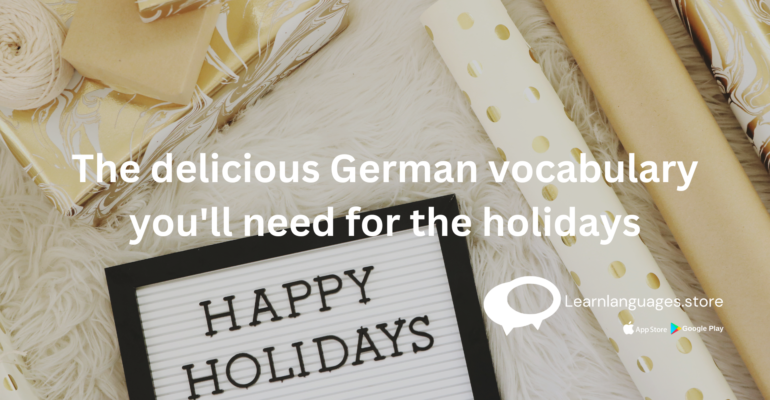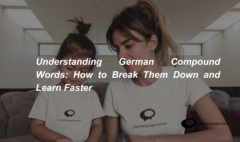The delicious German vocabulary you’ll need for the holidays
The delicious German vocabulary you’ll need for the holidays
Estimated reading time: 4 minutes

Christmas celebrations in German-speaking towns are a combination of warmth and sweetness, with family and friends getting together at Christmas markets and the aroma of seasonal treats filling the air, along with the tunes of the Austrian Christmas carol Silent Night. However, there is another, somewhat darker, tradition that exists in Austria alongside these joyous ones.
Wandering through the Christmas market
Christmas markets have a long history, having originated in the fourteenth century as a way for people to prepare for the harsh winters by stockpiling essentials. Weihnachtsmarkt is the common term for these markets; however, Christkindlmarkt is also used in Austria and southern Germany. Christmas markets have developed into a spectacle of different activities and an extensive assortment of Christmas decorations, trinkets, handcrafted items, and—perhaps most importantly—tasty food and beverages.
In all German-speaking regions, there are several treats and words for them. Glühwein (mulled wine) and Punsch (hot spiced punch), which is available in a range of flavors like Orangenpunsch (orange punch) and Beerenpunsch (berry punch), are crowd favorites. If you’re craving something sweet, try gebrannte Nüsse (candied nuts) and plain, jam-filled, or chocolate-covered Lebkuchen (gingerbread). For those with a taste for something savory, try Langos, a deep-fried yeast flatbread.
You can also discover local specialties and vocabulary at Austria’s Christkindlmärkte. There, you can order a Häferl, the Austrian word for “mug,” to accompany your Glühwein, or try Mozartpunsch, a creamy punch that is modeled after the well-known Mozartkugeln, which are chocolate pastries stuffed with nougat and marzipan. Try the Maroni (roasted chestnuts), Käsespätzle (cheese spaetzle), and Kaiserschmarrn (a sort of fluffy pancake with raisins, chopped up) served with Zwetschkenröster (stewed plums) to sate your appetite and stay warm.
It’s kind of terrifying outside, baby.
Warm beverages and sugary foods aren’t the only holiday customs in Austria! You may also come across a hideous creature with cowbell around its waist, shaggy fur, horns, a rod in its claw, and a terrifying face (often a hand-carved wooden mask)!
Introducing the Krampus, a legendary character whose goal in life is to punish and frighten kids who haven’t behaved well all year long. Thankfully, this tradition has two sides: The Krampus is a friendly adversary of Saint Nicholas, also known as Nikolaus, who visits well-behaved youngsters on December 5 or 6 and bestows modest presents such as chocolate, nuts, apples, and mandarin oranges. (In German, you’ll always use “the”; in English, you’ll probably see these names both with and without “the”—the Krampus or just Krampus!)
Attending a Krampuslauf, or Krampus run, where a large gathering of Krampusse (Krampuses) takes over a square or an entire street, is an option for those looking for an extra Christmas thrill. These gatherings provide a chance to get up close and personal with these eerie characters. But take note: Participants should make sure they’ve behaved well this year! 😈
A bit less time spent on Christmas Day waiting for a present
Those in Austria get to enjoy this moment a day sooner than many people across the world who patiently wait until December 25th to open their presents! On Heiligabend, or Christmas Eve, individuals exchange gifts, a custom known as Bescherung, and then have Christmas supper (or vice versa). The kid known as the Christkind, who has wings, a halo, and blonde hair, brings the presents rather than Santa Claus. Different cuisines have different traditions all around the nation. Some include crunchy fried Karpfen (carp), kalte Platte (cold cuts), or a substantial Weihnachtsgans (Christmas goose). An abundance of classic Christmas sweets, such as Linzer Augen (round shortcrust cookies with ground nuts, filled with jam), Vanillekipferl (vanilla crescents), or Florentiner (Florentine biscuits), typically cap out dinner.
To commemorate Silvester (New Year’s Eve), on December 31st, Raketen (firework rockets) and Sekt (sparkling wine) take the place of Weihnachtskekse (Christmas cookies). Many Austrians start their new year with music: All public radio stations play the Donauwalzer, or The Blue Danube, around midnight, which is the music that people prefer to waltz to. Millions of people watch the Vienna Philharmonics’ esteemed Neujahrskonzert (New Year’s concert) live throughout the globe on Neujahrstag, or New Year’s Day. Around 11:15 am CET, if you’re feeling particularly rested, check in and celebrate the start of the new year in true Austrian style!
Learn Languages Store
Vashi,
Email: services@learnlanguages.store










